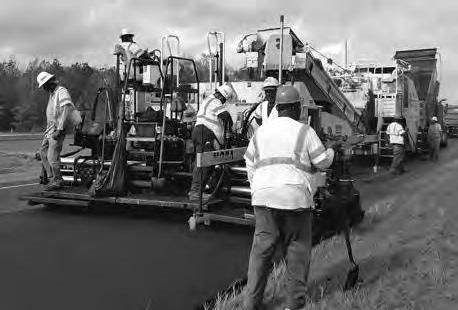
3 minute read
VOLVO CE CX01 Single-Drum Asphalt Compactor Concept
Page 72 • November 24, 2021 • www.constructionequipmentguide.com •Paving Section • Construction Equipment Guide Balanced Mix Design Process Proves to Be Highly Successful
By Buzz Powell and Brett Williams
SPECIAL TO CEG
Industry and agencies share a unified desire for pavements that perform well under the loads of the traveling public and the environments in which they are placed. Asphalt pavement mixture design has evolved as demands on pavements increase and as engineering continues to advance in building high-performance and cost-efficient pavements. That’s led to balanced mix design (BMD), which is proving successful in places like Alabama. But it might still be “new” to some road owners and mix producers.
What is BMD, how did it come to be, and what are its benefits?
The Path to BMD
The Strategic Highway Research Program (SHRP) introduced the Superior Performing Asphalt Pavement system (Superpave) in 1993 to implement performance testing and volumetric design methods to account for traffic and environment, as well as a new asphalt binder grading system. The intention was to replace Marshall stability and flow testing with a new test(s) that measured basic material properties that were more predictive of actual rutting and cracking performance.
While the Simple Performance Test (SPT) has undergone several iterations and a name change, it has not matured into a test that can be used during construction. In response to this mixture performance testing void, several different laboratory tests have been developed, many of them focused on the cracking performance of asphalt mixtures. Additionally, efforts have been made to formally shift the design focus toward balancing the cracking and rutting performance and away from some of the now well-established volumetric requirements.
When you dissect this design and testing trajectory, the factors critical to widescale adoption of the BMD process become apparent, empowering the industry to move toward mixtures that can outperform their predecessors.
A BMD Success
Many states have begun implementing BMD or are in the process of doing so. One such example provides perspective on how simple the approach can be while demonstrating meaningful advantages over the volumetric-based system.
The example BMD implementation dates back to summer 2019, when two Alabama counties (Geneva and Houston) sought advice from the National Center for Asphalt Technology (NCAT) to improve asphalt mixture quality for the purchase order materials the counties procure through annual contracts. Their initial inquiry stemmed from the idea of eliminating reclaimed asphalt pavement (RAP) from the mixtures to address performance concerns the counties had experienced with their pavements. But NCAT presented a different solution.
NCAT offered a simplified BMD approach that focused on rutting and cracking performance while allowing for increased RAP use. The approach required satisfactory performance testing during construction to ensure contracted materials would meet the counties’ performance expectations.
Let’s review some of the keys to implementation:
Performance
The new county specification was developed using mix performance thresholds tied to NCAT Pavement Test Track findings from the 2015-2021 cracking group experiment, which correlated field performance to laboratory performance testing. The specification threshold values for IDEAL-CT (50) and hot-IDT (17 psi) testing results in mixes that perform well in both rutting and cracking in the Alabama climate, using local aggregates and asphalt binders, as determined by testing conducted on numerous mixes from the region.
Determination of threshold values was an important step because BMD implementation should always be based on the proven performance of jurisdictional materials and mixes. Local asphalt producers embraced the specification change and quickly responded by evaluating their existing Superpave mixtures and determining the











